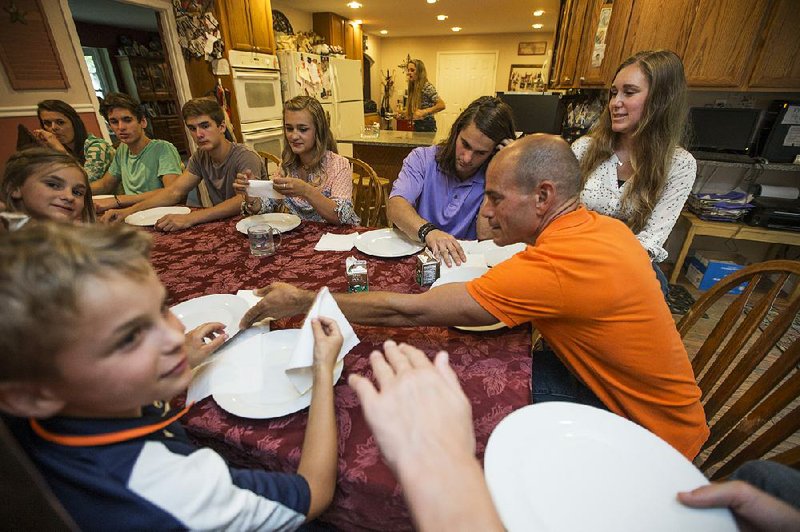Sam Fatzinger prowls the aisles of an Aldi grocery store with an engineer's precision. Workers greet her, mostly by name.
She puts several trays of chicken into a cart. Then it's on to fresh blueberries for $1.79 a pint. And she recalls the time the no-frills store had a sale on potatoes: 10 pounds for 99 cents. She bought 60 pounds. Her husband loves spuds.
To get these best buys, "it's just watching and waiting and knowing," Sam says. "Every cent counts."
At the cashier her groceries fill every inch of the conveyor belt. The bill: $127.
Very impressive. But not as impressive as this:
Rob and Sam Fatzinger, lifelong residents of Bowie, Md., lead a single-income family in one of the country's most expensive regions. Rob's income never topped $50,000 until he was 40. At 51, he earns just north of $100,000 as a software tester.
They have 13 children, which means they require things like a seven-bedroom house and a 15-passenger van. Four children have graduated from college, three are undergrads and six are on the runway.
Yet they paid off their mortgage early four years ago. They have no debt -- never have, besides mortgages. And Rob is on track to retire by 62.
This family gets the gold medal for being frugal. This family is the Einstein of economical.
Rob's philosophy: "Spend money on what makes you truly happy and on what you enjoy. ... The thing that people need to understand is that we don't feel deprived or poor. ... We pick and choose carefully."
...
Frugality is hardly new. In 1789, George Washington wrote to Marquis de Lafayette, the French military officer who fought for the American Revolution: "Nothing but harmony, honesty, industry and frugality are necessary to make us a great and happy people."
Americans were frugal people well into the 20th century. Then came the era of instant credit, rampant consumerism and record personal bankruptcies.
Recently, frugality has gotten a boost thanks to hundreds of personal-finance bloggers, and no thanks at all to the Great Recession of 2007-2009. Many focus on FIRE, an acronym for Financial Independence/Retire Early. Aspirants often strive to save at least 25 percent of their take-home pay over the years, or even twice that -- or more -- to feel financially secure or to pursue a new career. Others yearn to quit their jobs for the long haul, even in their 30s.
The best personal-finance bloggers are innovative, funny and surprisingly philosophical as they chart a course for change and places unknown. They're about ideas and possibilities, not suffering. And millions are listening.
Frugalism is often about math, determination and thinking a bit differently. A few key principles: How much you save, as a percentage of your paycheck, will foretell when you'll be able to build your business or retire. Small financial changes can make a big impact. And it's not really about your income, it's about your savings, says Pete Adeney, a lapsed engineer from outside Boulder, Colo., who created the popular Mr. Money Mustache blog.
And then there's the "miracle" of compounding interest, the gift that keeps giving as your investment's interest spawns its own interest, time and again.
...
The Fatzingers would never claim
to be financial magicians, but to outsiders, it might look that way.
After marrying 27 years ago, Sam and Rob started a small Christian bookstore in Crofton, Md., and soon had a daughter. Rob says the couple never earned more than $36,000 a year in the business. Still, they saved 10 to 15 percent of their earnings. By the time they shuttered the store in 2000, they had seven kids.
About 10 years ago, Rob got the job testing software. Earnings of $40,000 gave way to $60,000 and are now about $110,000, counting a few thousand from mowing neighbors' lawns and other tasks.
Back in 2000, they bought a five-bedroom house out of foreclosure and later added three bedrooms. Nine children, including the youngest, who is 4, live there now.
The good news: The house cost $150,000. The Fatzingers paid down $50,000, saving interest on the 15-year mortgage.
Years later, they enlarged the kitchen, using two zero-percent finance offers good for 12 months. Eleven months later, they paid off the loan, without paying any interest. The project cost $28,000, with family members doing much of the demolition, painting and decorating.
Now they have two refrigerators, two stoves, two dishwashers and a welcoming, comfortable home. Since the mortgage was paid off in 2012, Rob and Sam have turbo-charged their savings rate, now investing about $3,000 a month.
Even so, they don't go without. Sam has a
$10 monthly gym membership, and Rob and Sam go out for lunch on the 20th of each month, maybe at Red Robin Gourmet Burgers and Brews in Bowie, marking the day of the month they got married.
Rob, 51, is soft-spoken, a work-from-home dad and a former American Idol fan. Sam, who is 48, home-schools the children through
high school and is certified to do so. The kids also get outside tutoring. Her nonacademic lessons extend to the rules and responsibility
of money.
"My kids all get jobs as soon as they're old enough," she says, and they "learn to discern between needs and wants. They pay for their cellphones, they pay for college, they pay for their own gas."
Allowances? Nope.
Daughter Barbara, 20, a rising senior at the University of Maryland Baltimore County, started baby-sitting at 11. She got her first "real job" at Rita's Italian Ice. Baby-sitting, she notes, "paid way more than Rita's."
When she was 15, Barbara bought a 1994 Ford Escort with 30,000 miles for $2,600 from her savings.
"It sat in the driveway until I got my driver's permit," she says. Five years later, "I still drive it."
The family shops at sales or secondhand stores and checks out the Freecycle Network, a site for giving away belongings. Friends and strangers also chip in.
"We always have someone dropping off a bike," Sam says. "We would get things and not even know where they came from."
Fine, except this is America. Surely the kids are seething cauldrons of Nike-deprived resentment. Or maybe not.
"I always had a ton of clothes," Barbara says. "I would go with Grandma and buy any cute clothes I wanted."
...
These days, even the childless can be terrified of college costs, so just imagine having 13 kids. But the Fatzingers have a strategy, and it's working.
The plan: Start in community college, don't expect a handout from Mom and Dad, and graduate debt-free. So far, Alexandria, the oldest at 26, graduated at 21 with a master's degree in social work. Joshua, 25, graduated from the University of Maryland with a degree in kinesiology and became a missionary. Caleb, 23, is in the last year of a doctoral program in physical therapy at the University of Maryland at Baltimore. And Lizzie, 21, graduated in May from the University of Maryland with a math major, while also cleaning houses and tutoring. All four graduated from college debt-free. All five oldest Fatzingers have gone first to Anne Arundel Community College.
In Barbara's first semester, her tuition, textbooks and gas money were covered by scholarships and other aid. In her second semester, she spent "probably $500" in tuition. The next year, she paid $700 to $1,000 per semester. After two years, she had paid about $2,500 at most. It came from savings and her job in a child-care center at a gym.
In September, Barbara started at University of Maryland Baltimore County, a public university with higher expenses. Her first year there cost about $15,000, after receiving a $5,800 scholarship based on grades and financial need. Money was tight. Again, she paid with her savings, which included money from a grandparent, who gives each child a one-time gift of $5,000 for college. Barbara used some of the gift money to stay in school, but she's saving most of it.
She will soon begin her senior year. She has a $7,500 stipend for tuition and five small scholarships "that will fill the holes." In return for the stipend, she'll work for a state child-welfare program. Barbara has decided to live at home this year, which means she'll be commuting and "won't be spending at all," she says in a text message. "And I WILL graduate debt-free."
Next year, she'll follow in oldest sister Alex's footsteps, pursuing her master's degree in social work at another school, which could take one or two years. A Maryland program will pay most of her tuition, and in exchange, she'll work for a child-welfare agency for two or three years after she graduates. In total, roughly speaking, Barbara has paid about $17,500 out of pocket for tuition, books, supplies and fees for four years of college.
Caleb was fine in community college, where he paid "essentially nothing," in part because of his good grades and aid. And he graduated debt-free at Towson University, a public state school, where he worked in the admissions office. But when he began the doctoral program in physical therapy two years ago, he had to take out a loan. With aid more scarce in grad school, he says he'll end up owing almost $90,000.
"I think about it a good amount," says Caleb, who started working as a physical therapy technician at 18. "I try not to worry too much.
"I think I've done the best I can."
Family on 08/24/2016



